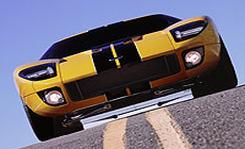
 First Drive Review
First Drive Review
It's official: Ford will build the GT40. Can't wait? Our Web exclusives will take you for an inside look at the GT40, including a photo retrospective and interviews with Chief Engineer of Ford SVT Engineering John Coletti, Vice-President of North American Product Development Chris Theodore, GT40 Designer Camilo Pardo, and Design Vice-President J Mays.
In these trying times, we're all inclined to seek out heroes. Even automotive ones. And as automotive heroes go, Ford's GT40 was to endurance racing what Gen. George Patton was to European butt kicking--crass, confident, and highly effective.
The year was 1963. Henry Ford II decided he needed to win the famous 24-hour endurance race at Le Mans. That March, he entered negotiations to join forces with Ferrari, but Enzo Ferrari halted talks abruptly on May 21. This steeled Henry's resolve to beat Enzo if he couldn't join him. Funds were allocated to construct a Yank-powered GT car built with help from Britain's Lola. In 1966, the dream was realized with GT40s finishing one-two-three at Le Mans. Ford's winning streak stretched through 1969, by which time Ferrari had withdrawn from the series. Is it any wonder, then, that Ford's Living Legends styling studio should follow up its T-Bird and Forty-Nine designs with a reincarnation of the fabled GT40?


Of course, this is not Ford's first GT40 homage. Remember the angular, geometric, completely modern GT90 that bowed at the 1995 Detroit show (C/D, January 1995)? That car's raison d'être was to prepare the public for the "new edge" designs that followed with the Cougar, Focus, and others. The GT90 was blatantly unfeasible--improbably low, impossibly expensive, and generally too extreme. This one has been designed as a fast, comfortable street-legal car that could see limited production. Its mission, therefore, is to ask well-heeled showgoers the $100,000 question: Can you live without one?
Comfort and legality mandates drove a 10-percent increase in the overall dimensions of the new car relative to the Mark I GT40. The wheelbase is stretched nearly a foot, the height goes up three inches from 40.5 inches (a figure that was rounded down to 40 in the naming of the original car) to 43.5 inches. Overall length stretches 17.1 inches longer than the original's 164.5. The passenger compartment is situated slightly farther aft within the wheelbase to lessen the intrusion of the front wheel wells. The seats are located outboard of a wide central backbone structure that houses the fuel cell, rather than inboard of two giant sills that housed the gas tanks in the original. Another wonderful concession to ingress/egress is the way the conventionally hinged doors wrap up into the roof, as the original doors did.
Design boss J Mays insisted on one more original design element--the large front and rear access panels, hinged near the bumpers, which open to expose all the car's mechanical systems. That requirement added considerably to Special Vehicle Engineering chief John Coletti's to-do list. Coletti was assigned to sort out the show car's running gear, and he would not have the world photographing ugly, half-baked, or ill-designed hardware. Hence, the Detroit show car's underpinnings are both geometrically realistic and functional.